Today, at precisely 12 pm, the sirens will sound all over Singapore to mark the darkest period in our nation’s history. 71 years ago on 15th February, the British surrendered to the Japanese after the devastating defeat of Singapore’s last strategic post of Bukit Chandu (Opium Hill.) Read Jerome Lim’s moving tribute to those who died valiantly to protect Singapore in that battle here.
a.t bukitbrown remembers the war by sharing the life and times of Tay Koh Yat, one of the war heroes buried in Bukit Brown.
Tay Koh Yat (1880 – 1957)
He was a pioneer in Singapore’s public transportation, but also a feisty patriot who started and led his own self defence force of 20,000 during the onset of the Japanese Occupation of Singapore in World War 2.
His grave located near the Bukit Brown cemetery gates is a fairly well maintained tomb and comes with benches, as if to offer a chance for people to gather and talk about his legendary deeds. The funeral cortege for Tay was grand with a reported 100 cars in attendance.
Tay was born in 1880 in Kinmen and came to Singapore when he was 22 years old. He started as a general worker in a trading company and was paid $2 a month. $1.50 was sent home to his family. Tay managed to survive on what was left because at that time, the meals, transport, housing was provided by his employer. So 50 cents was a luxury to be spend on aerated water or some porridge at hawker stalls. 2 bowls of porridge would cost only 1 copper coin, and 1 cent was equivalent to 4 copper coins.
After working for more than 10years, Tay saved up enough to start his own small firm, dealing with salted fish. He was just 26 years old. His reputation for being hard working and trustworthy led to the expansion of his business in Indonesia
In 1938, Tay noticed that local transportation was inadequate and started the Tay Koh Yat Bus Company. He built up his fleet to 120 buses and became the largest bus operator among the 10 other bus companies.
But more than buses, Tay was admired for his patriotism and daring do in leading a 20,000 strong self defence force which he formed just before the Japanese invasion. His rallying cry “20,000 people, one heart.” The force helped to maintain order and prevent panic and chaos as people started to flee the country with the invasion of the Japanese forces.
Tay stood his ground until the eleventh hour and escaped to Indonesia to escape certain death only on the eve of the fall of Singapore. He was on the Japanese most wanted list. But before he left he had organised a 2000 strong rescue team, for people who injured by the Japanese air raids.
After the war, Tay returned and immediately started to compile the fatalities from his volunteer force and lobbied the colonial government for the same compensation given to widows and children of servicemen who died during the war. Initially rejected, he appealed and the government finally gave in.
Tay next went on to form the Singapore Chinese Appeal Committee for the Japanese Massacre victims to seek justice and compensation. It was estimated that some 50,000 people had died under Japanese hands.
In March 10, 1947, the War tribunal committee found Lieutenant General Kawamura Saburo, Singapore garrison commander and Lieutenant Colonel Oishi Masayuki Kempeitai commander guilty of war crimes and sentenced them to hang.
They had been in charge of the Sook Qing operation in Singapore which massacred thousands of ethnic Chinese.
Tay was invited to witness the execution of the two war criminals. Tay was one of only six people to witness the execution, such was his standing in the community. And, on seeing the two generals, he burst out in anger and sorrow:
“You have committed big sins and really deserve to die, but even when your soul descends to hell to suffer further punishment, still it is not enough to atone for your sins.”
Tay Koh Yat never lost his fiery nature. During the riots of the early 50s of union unrest and political instability, Tay who was by then also managing a newspaper became an indirect target. One day he received a phone call that 4 young people were burning his buses near Rex Cinema. He got his driver to take him to the scene of the arson. When he saw 2 young men burning his bus, he caught hold of one of them and exclaimed “How dare you, burn my bus!” But at 70 he was no match against a young rioter and barely escaped.
Tay Koh Yat’s tomb is in the line of the proposed new highway that cuts through Bukit Brown and his grave is slated to be exhumed, finally uprooting a pioneer and a hero who had always stood his ground.
His tomb is marked as A1 at Blk 5 division 1
A postscript on Bukit Brown ‘s war years: Many of the those who died during the 3 1/2 years of the Japanese Occupation had to be buried hastily in mass plots without tombs at the Paupers Section. They remain largely unknown.
A Singaporean recalls praying at the site of a similar mass grave where one of his relatives was buried during the war. The circumstances then dictated that bodies were collected and buried in a communal trench. This is in Block 5.
***
Here’s another blog on another war hero buried at Bukit Brown: Wong Chin Yoke. (credit: the Rojak Librarian)
Here’s a newspaper article on Wong Chin Yoke.
***
Other family details:

Marriage certificate of Tay Koh Yat’s daughter with Tan Ean Kiam as marriage solemnizer and 5 colored flag, the national flag at that time (on display at the Sun Yat Sen Memorial Hall)
A grandfather weighs in on Saving Bukit Brown for future generation.
Calling all shutter bugs, share your best work on the Bukit Brown Gallery
Choose your best 8 photographs, caption it, theme it, tell us how you captured it, whatever you like.
Tell us a something about yourself and your interest in Bukit Brown
We will devote each new blog posting to your photographs
The penultimate goal – to build up enough to launch an exhibition, the ultimate goal – a book!
Send your contributions to a.t.bukitbrown@gmail.com
When word gets round that an organised group is about to descend on Bukit Brown, you’ll almost be certain to find Master Lim Su Min and his mobile tea station.
He made his first appearance on Boxing Day last year in an event organized by the Bukit Brown face book group to work off the Christmas feasting with a brisk walk, jog or cycle in the grounds.
Su Min decided he will offer freshly brewed fine Chinese tea on the ground as an incentive after the “work out”. Today, when he is not on his travels to do community service around the region, he is a fixture under the same shady tree which he has claimed for his tea station. Even when overseas, Bukit Brown is always close to his heart as he looks out for interesting teas for the next serving.
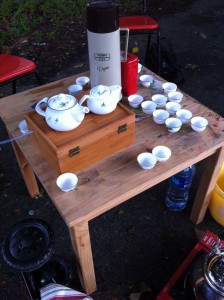
Custom is brisk. The offering this day was lapsong suchong. One thimble full of tea is never quite enough and one regular customer has threatened to bring her own mug.
His, is the stuff of gung fu. Bottled water on standby, a portable stove on standby to heat the water to replenish his thermos, and the ritual of warming and rinsing of tea cups before the brew is offered to be sipped.
Master Lim is a man of many talents.
And he can be moved to pen a haiku or two.
“Tea leaves instilling:
Peace our souls are resting
Tranquility eternal
Ladies and Gentlemen, we present Lim Su Min, tea master extraordinaire and poet in virtual residence at Bukit Brown.
As Su Min operates only under artistic license, his tea is complimentary and yes, refills are allowed while stocks last. He has as yet not run out.
The Banded Woodpecker and The Laced Woodpecker were spotted and filmed at Bukit Brown by sgbeachbum, the moniker of a nature buff who haunts Bukit Brown and natural habitats documenting and sharing Singapore’s natural treasures for generations to come.
banded woodpecker cooling off @ bukit brown 15Jan2012 from SgBeachBum on Vimeo.
http://vimeo.com/36165497
a.t.Bukit Brown imagines what a conversation with George Henry Brown would be like….
a.t.Bukit Brown: Welcome to Bukit Brown Cemetery, Mr. Brown. Thanks for making the trip from Penang. Does this place bring back any memories for you at all?
Mr. Brown: Amazing! I had heard in the “grave vine” I had a cemetery named after me in Singapore but this leaves me somewhat speechless. I lived close by to this place, on a hill called Mount Pleasant Road. And this whole area was hilly and wild. This is peaceful and beautifully lush, yet tamed. And I see you have some horse-riders taking their morning constitution. Lovely.
a.t.Bukit Brown: Describe the area you lived in back in the 1840s.
Mr. Brown: Wild. I bought a large plot just off Thomson Road. It was then thick jungle and tigers roamed. I shot one once and it was exhilarating. I cleared a large part of it and planted nutmeg and coffee but unfortunately it didn’t take. But I liked the area, and in particular one hill which I thought was rather pleasant – hence Mount Pleasant Road – so I built my home there and a few cottages. One of my trusted staff lived in Fern Cottage. He wrote a spiffy account of the environs which can be found in a book “One Hundred Years of Singapore” – an account of the days of the Straits Settlements from its foundation by Sir Stamford Raffles, circa 1819. Let me read from it:
“The jungle round is full of wild animals; pig, deer, tigers, and many snakes. Mamma encountered no less than three snakes one morning before breakfast, when going her rounds to the fowl-houses, and the mandor captured a python sixteen feet long, sneaking off with a fowl at the foot of our hill, not 200 yards from our cottage, which mamma, who has a particular horror of snakes, was shown coiled up in a fowl basket. There is a small stream at the foot of our hill, and we are constantly finding tiger tracks there. One evening, when I was fishing (there was a stream nearby), I heard a rustle and a lapping sound, and just caught sight of Master Stripes in the lallang on the opposite side: my heart was in my mouth, ‘as I dared not move for fear of attracting his attention; but as soon as he made off, I bolted for dear life up the hill.”
a.t.Bukit Brown: And the name of this intrepid staff member?
Mr. Brown: A certain Mr.G.M.Dare. He lived at the cottage with his mother and sisters.
a.t.Bukit Brown: Rather aptly named. Let’s go back earlier in time. Recall for us when you first arrived on these shores.
Mr. Brown: I had initially settled in Penang in 1840 when I came from Calcutta. Those were the glory days of the Great Empire where young men would seek their fortunes in the East. I decided to move down to Singapore from Penang 2 years later. I started G H Brown & Co in 1 Jul 1854 as Merchants and Commission Agents.
Now that was a rather fortuitous year – 1854 – as that same year Ellen whom I would marry arrived in Singapore. At age 27, she would have been considered as being left on the shelf at home. But thank goodness she was still single. We fell in love and married on 20th April 1856. We raised a family of three daughters – Eva Caroline, Charlotte Ellen and Lucy Meda – with my son George William Brown, or “Georgie” as he was affectionately known. He was from my first marriage.
Ellen’s brother Arthur Knight came in 1860 to help me in my business and he would later become a prominent figure in his own right in Singapore. Arthur and I established ourselves as Brown, Knight & Co. at Malacca Street in 1865 and we owned several ships for example the 800 MT Malacca and the Christian. We moved the business to Raffle Place later.
We lived together in the Mount Pleasant home which sprawled over 140 acres. It was also known as Brown’s Hill by the locals. We had became (clears throat) rather prominent and kept company with the Who’s Who’s in Singapore then such as Thomas Scott Thomson, Charles Dunlop, Tan Kim Ching, Tan Jiak Kim, Tan Boo Liat, etc. It was the 1860s and life was good.
a.t.Bukit Brown: I understand Anna Leonowens was a regular guest in your home.
Mr.Brown: Yes, Ellen had taken a shine to Anna and when Anna’s husband died so unexpectedly in Penang in 1859 at such a young age, she was quite heartbroken. She came down to Singapore to stay. We were all concerned as to how she would carry on: a young widow with a young son she was quite beside herself with worry and grief.
Ellen and Anna had discussed and considered various options at length including setting up a school to teach English. But finally in 1862, Anna accepted an invitation by merchant Tan Kim Ching – we socialised with him quite a lot – to teach English to the King of Siam’s family. Now there’s an interesting connection in international diplomacy between Singapore and Thailand. Ties between Tan Kim Ching and the Siamese court were close. But that is another story for another person to tell.
a.t.Bukit Brown: Yes, we will follow up on that. You might be interested to know that Anna was the inspiration for a smash hit musical based on her life teaching the children of the King of Siam called “The King and I”
Mr. Brown: Yes I had wind of that where I am. But who would have thought that Anna would be so immortalised. It was a good thing that Kim Ching did for her. She was quite partial to music as I am.
a.t.Bukit Brown: Do tell.
Mr. Brown: I play the piano and violin and was good enough to be the honorary organist for St Andrews Cathedral. Ellen and I would host musical soirees in our home in Mount Pleasant. Ellen sang. There was a lot of music in our home, very uplifting. You must try and get a hold of Ellen’s diaries. She kept beautiful records of life at home, family and friends and includes some escapades with the wild life which surrounded our home. A god-fearing woman was my Ellen. It was a shame the Mount Pleasant estate had to be sold in 1883, after I left.
a.t.Bukit Brown: What happened?
Mr: Brown: An unfortunate accident. I have always had a mechanical bent and liked “tinkering” about with machinery. In my younger days, I even made my own carriages and they were quite fine pieces of finish and durability if I may say so myself. Well, I started growing tapioca on my estate when I was in my early 60s. I was operating a tapioca cutting machine when I had a rather terrible accident and I lost my left arm. I went to Penang to recuperate. It was there in Penang on 5 Oct 1882 that I left this world. My resting place is in Penang. I share the same cemetery as Francis Light, Penang’s founder. In death I find myself still in illustrious company.
a.t.Bukit Brown: Here too at Bukit Brown, are pioneers of the land and those who toiled humbly for the country. Your old friend Tan Kim Ching is here too.
Mr. Brown: Ah I will go and say hello before I go. We have much to reminisce.
a.t.Bukit Brown: We have a map to share with you.
Mr. Brown: Very kind. But I reckon I will have no problem locating him. But pray tell what are these numbered wooden stakes I see?
a.t.Bukit Brown: They are in the process of identifying graves which have to be exhumed make way for a new 8 lane highway which is slated to be built in 2013.
Mr. Brown: Oh good grief as another Brown might say. This is sad news. I must not tarry then, less I be mowed over.
*Interviewer’s Note: Mr. Brown just disappeared with a twinkle in his eye before we had a chance to ask him whether he would have liked to have been laid to rest in Bukit Brown. Mr. Brown if you are reading this we hope you had a very pleasant journey home to Penang and hope you will come again to share more stories.
George Henry Brown 1818-1882
Tan Kheam Hock (1862 – 1922)
The fact that Bukit Brown was established as a municipal cemetery (1922) for the Chinese community – rich and poor – owes much to the active lobbying by the then Municipal Commissioner Tan Kheam Hock. In recognition of his effort, the new road leading to the cemetery was named in honour of him, a year after his death in 1922. Today, it is still the scenic route to Bukit Brown Cemetery.
Tan was born in Penang in 1862 to a rich merchant. As a young man, he studied at the Penang Free School, and upon graduating was given a position in the Chartered Mercantile Bank of India, London and China. Eight years after working, in 1887, he decided it was time to broaden his life and work experience by traveling. He headed to Calcutta and learnt about agricultural production over a two-year period. He arrived in Singapore in 1889 and got into the business at the Opium and Spirit Farm. The business had nothing to do with growing crops but was formed to exploit the system of government tenders awarded for the processing of opium and liquor, both valuable sources of revenue for the Straits Settlement government.
He was continuously associated with that enterprise until 1906, except for an interval of 3 years (1898 – 1900) when the farm contract fell into other hands.
Like most Chinese business men, he diversified his business interests. In December 1901, Tan secured a contract to supply labourers from China (coolies) to the Tanjong Pagar Dock Co. as Singapore developed from strength to strength as a port city. To get an idea of the worth of that contract, it was recorded that the wharf frontage of the docks was over a mile and a half in length, and as many as 2,500 coolies had to be permanently employed there.
He became the Municipal Commissioner in 1910 and held the post until his death.
Tan was also connected with the Perak General Farms, and had a seat on the management committee of the Straits and Federated Malay States Government Medical School.
Kheam Hock family in traditional garb
He was known for his progressive ideas, a champion for the education of Chinese girls and actively involved in movements to improve the welfare of the Chinese community for much of his life, which extended to the welfare of the dead in the form of establishing a final resting place for the community.
Tan was a member of the Society of Arts, London and a scholar who helped to translate various Chinese classics to Baba Malay literary works. Most of the Baba translations were historical and heroic stories.
Tan made a well-connected marriage to the sixth daughter of the late Mr Foo Tye Sin, JP Municipal Commissioner of Penang (Tye Sin Street in Georgetown, Penang is named after him). Tan and his wife Foo Bing Neo had nine sons and two daughters, and 29 grandchildren at the time of his death.
Tan Kheam Hock died in 1922. He had requested for a simple funeral but the procession that followed the cortege stretched for half a mile, according to the newspaper records of the day. The body left his residence, 106 River Valley Road, with musicians, two large lanterns and the coolies bearing the estimated 200 wreaths, accompanied by Buddhist monks from the Telok Ayer temple. The procession wended its way down Kiliney Road, Orchard Road down to the cemetery at Alexandra Road. Prominent members of the community and a motorcade attended the funeral. He and his wife’s tombs were later relocated to Bukit Brown Cemetery, probably in the 1930’s.
Tan’s grave plot has three tombs but only he and his wife are interred there.
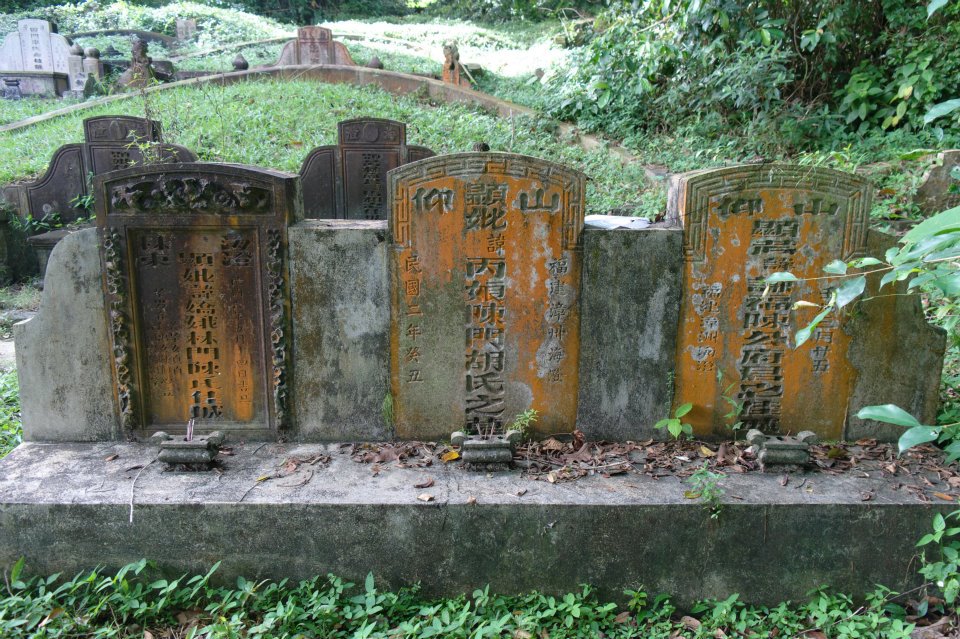
Tan Kheam Hock Tomb, simple and austere. Buried with his wife, Foo Bing Neo. The third tombstone is believed to belong to their eldest daughter Tan Mah Siang who died at 32.
Tan Kheam Hock triple tombs is marked as “S” located at Blk division 3 on the map. It is visible from the road.
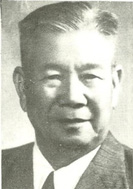
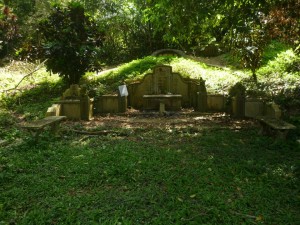
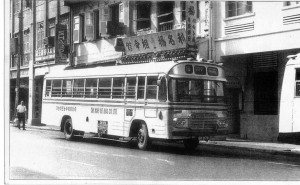



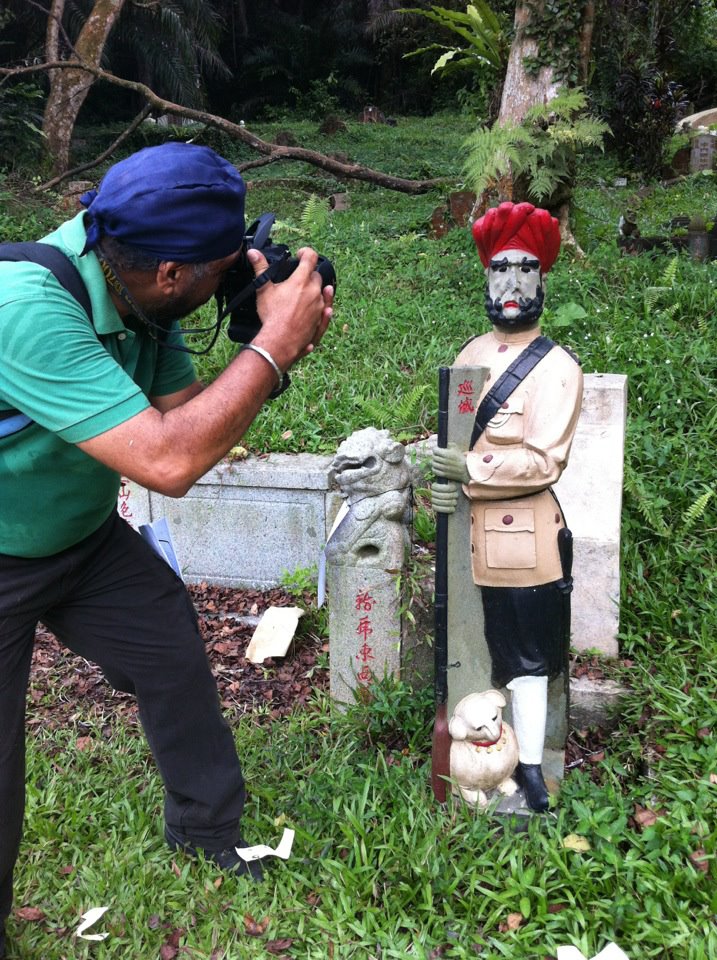
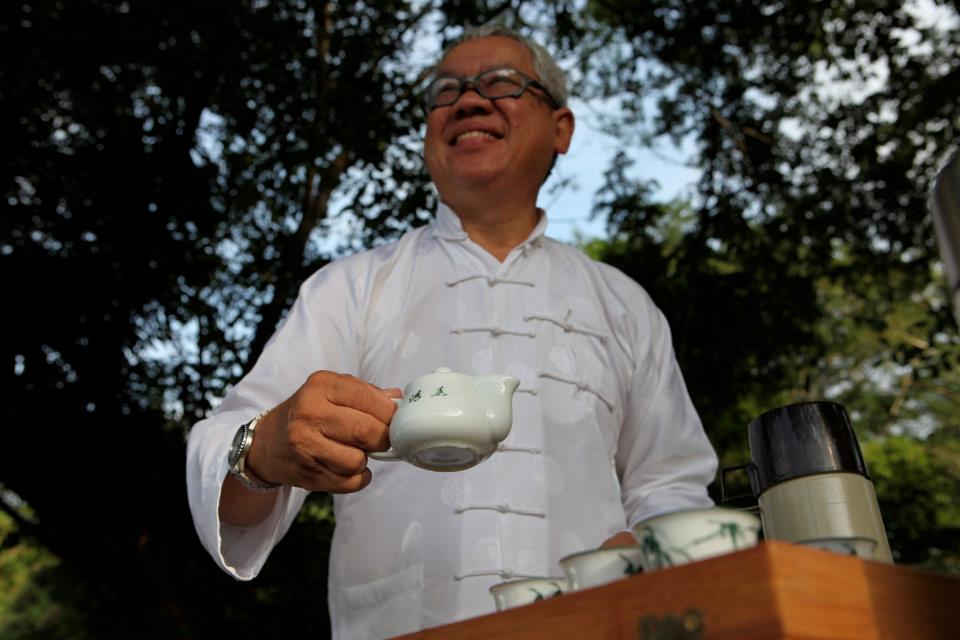
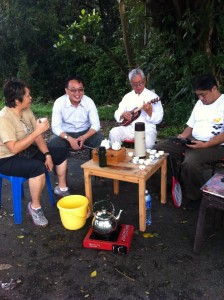
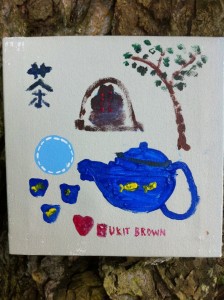





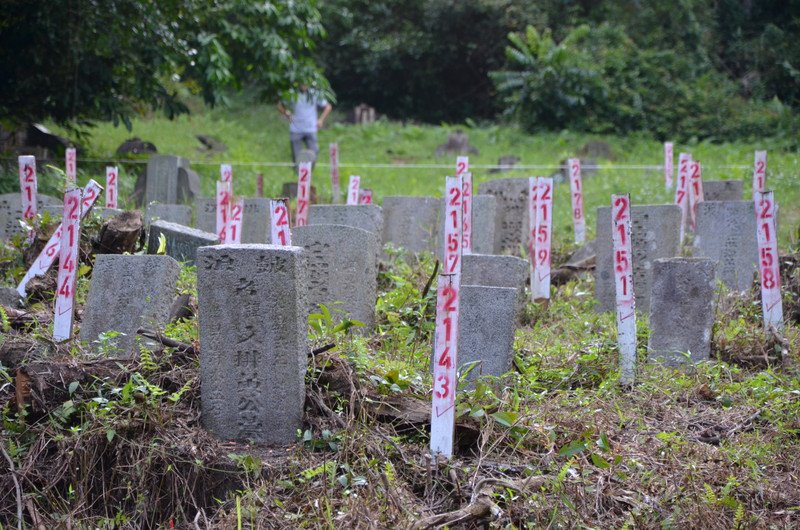
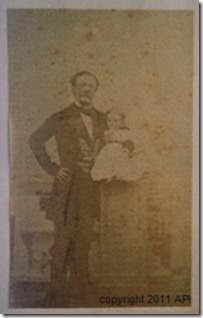


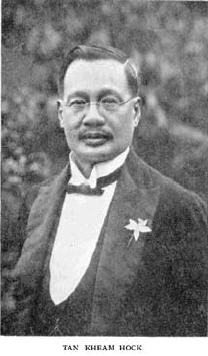
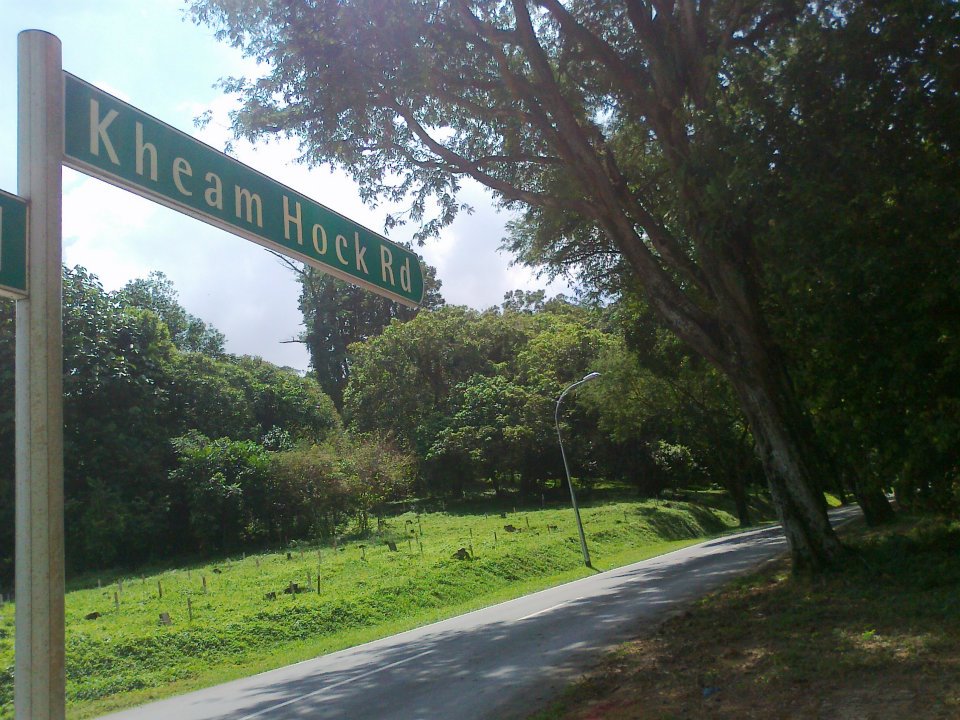
Recent Comments